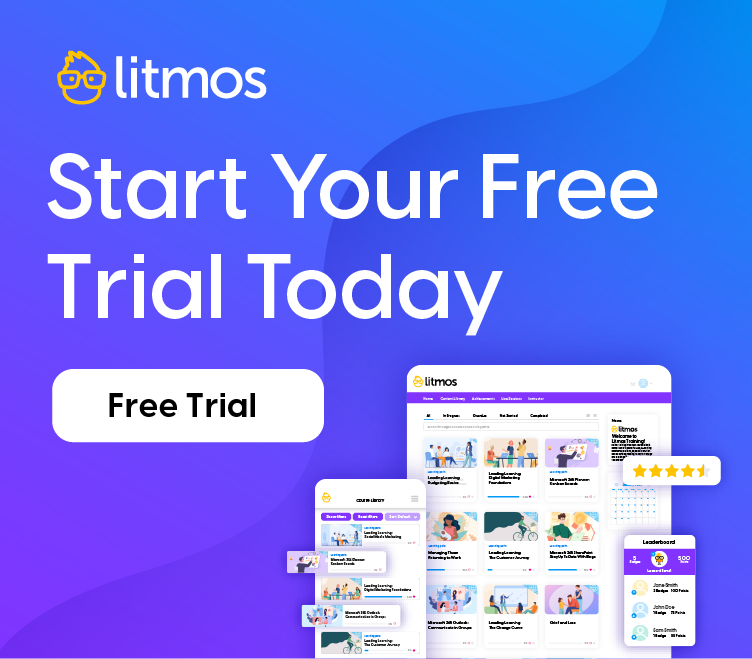Your Essential Guide to L&D Best Practices: Joy of Learning
A Deep Dive Into “Joy of Learning,” a Playful and Engaging Guide to L&D from Litmos
Key Takeaways:
|
Every organization needs some form of Learning and Development (L&D), whether they’re training employees, customers, partners, or volunteers. But leaders in charge of L&D are often left wondering how they can make their training programs a little more engaging. After all, who says that workplace learning has to be bland?
Litmos has long been on a mission to spice up L&D and bring the joy back to learning. One of the best examples of our unique approach to building an engaging L&D strategy is captured in our most popular eBook “Joy of Learning: Recipes & Ideas to Nourish Learners” – a playful yet informative L&D best practices guide that we created in 2023, which remains just as relevant and impactful to date.
This article is your guide to better understanding essential learning and development best practices explored in this eBook – a resource that anyone in your organization can skim for eLearning tips and inspiration!
Why Rediscovering Joy in L&D Is Key to Employee Engagement
Widely recognized as one of the most popular American cookbooks of all time, “Joy of Cooking” was released in 1931 and remains a staple in household kitchens to this day. Inspired by the iconic illustrations and timeless recipes of this home cooking classic, Litmos released its own cookbook of sorts – an eBook titled “The Joy of Learning: Recipes & Ideas to Nourish Learners.”
In tribute to the original cookbook, the digital pages of our “Joy of Learning” eBook feature the Litmos mascot, Lenny, donning a chef’s hat and sharing tips and best practices for making L&D programs more enticing, enriching, and enjoyable for every learner across the organization.
The Benefits of More Joyful L&D Training Programs
L&D professionals, Sales managers, CX managers, and others involved in employee training often have many pressures and deliverables to juggle. For this reason, we designed “The Joy of Learning” eBook to be engaging and easy-to-follow – making L&D best practices just a little more… digestible!
Many professionals involved in workplace training are looking for L&D guides that will help them create memorable and engaging learning experiences that their teams will actually like. But many busy decision-makers likely don’t have time to scour academic papers on adult learning theory, or 50-page reports on the latest trends in L&D.
With that in mind, the Litmos team decided to create an L&D best practices eBook that would be as handy and useful to trainers as “Joy of Cooking” is to home cooks. This truly unique resource aims to not only inform learning professionals but inspire them to add just a little bit of flavor to their approach to employee development.
Ready to set the table for an L&D feast? Throw a complete L&D dinner party, from hors d’oeuvres to desserts, with Chef Lenny as your guide. By cracking open this eBook, you’ll find new and proven ways to delight learners with differing and discerning palettes. Let our delightfully illustrated pages guide you in drawing learners to the table:
| Download the full “The Joy of Learning” eBook here |
A Taste of The Litmos “Joy of Learning” Guide
Hungry for more engaging and effective learning programs? Think of this article as an amuse-bouche for the main course.
In “Joy of Learning,” each section explores L&D as though it were a meal, with every essential element of workplace learning split out into a different course. This article will walk you through those courses, outlining the topics and key learnings from each chapter of our wildly popular “Joy of Learning” eBook.
You can expect to walk away from this article with a better idea of what’s included in the eBook, as well as a few practical insights and actionable strategies that you can use to cook up your own delectable L&D program.
Read on to explore the menu…
Microlearning: The Hors d’Oeuvres of Your L&D Strategy
In the ‘HORS D’OEUVRES’ section of the “Joy of Learning,” the reader is introduced to the concept of Microlearning. Just as hors d’oeuvres are small, easily digestible bites that whet the appetite, microlearning offers small, focused pieces of content that can be consumed on-the-go.
Chef Lenny recommends “glazing” these micro-bites with trending topics and shaping them into mobile-first, “finger-friendly” formats. The goal of any good microlearning “hors d’oeuvre” is to provide learners with an engaging yet convenient learning experience that makes them want another bite.
Key Benefits of Microlearning
- Increased Engagement: Short, focused content is more likely to hold learners’ attention and keep them engaged. This technique helps prevent cognitive overload, fostering better retention of information.
- Flexibility: Learners can access microlearning content at their own pace and in their preferred format, whether it’s a video, infographic, or a quick quiz. Building adaptability into learning experiences can cater to diverse learning preferences, enhancing the effectiveness of training.
- Continuous Learning: Microlearning allows for frequent updates and new content, keeping the learning experience fresh and relevant. By regularly introducing new material, learners remain motivated and continually expand their breadth of knowledge.
Tips for Tasty Microlearning Modules
- Content Chunking: Divide larger topics into smaller, manageable pieces.
- Mobile-First Design: Ensure that content is optimized for mobile learning, making training accessible anytime, anywhere.
- Regular Updates: Continuously update and refine content to keep it current and engaging.
Continuous Learning Improvement in L&D: Your Craft Cocktail
In the ‘CRAFT COCKTAIL’ section of “Joy of Learning,” continuous L&D improvement is the main focus. Just as a well-crafted cocktail balances unique and familiar flavors, this section encourages a balance between innovative and traditional learning methods to continuously iterate on and enhance an organization’s L&D strategy.
Chef Lenny emphasizes the importance of presentation. Just as a guest at a restaurant is enticed by the colors and textures of an impeccably crafted cocktail, a learner will be drawn to more visually appealing learning materials. Quick and seamless delivery will encourage learners to tuck into their training.
And just as a restauranteur values customer reviews, so must L&D prioritize learner feedback. The eBook highlights the regular gathering of feedback as a critical element for successful L&D, and Chef Lenny encourages using that feedback to improve future learning experiences.
Key Benefits of Feedback in L&D
- Personalization: Understanding learners’ preferences allows for the creation of personalized learning paths. This can lead to more effective and engaging learning experiences tailored to individual needs.
- Relevance: Feedback helps ensure that the content is relevant and valuable to the learners. By aligning training material with real-world applications that matter to participants, the training can becomes more impactful.
- Continuous Improvement: Regular feedback and performance data enable ongoing refinement and enhancement of the learning experience. This iterative process helps in maintaining the quality and effectiveness of training programs.
How to Balance Feedback for a Smooth Finish
- Surveys and Polls: Use these tools to gather insights on learners’ preferences and areas for improvement.
- Focus Groups: Conduct focus groups to gain deeper insights into learners’ needs and experiences.
- Analytics: Leverage LMS analytics to track learner engagement and performance.
Tailored Sales & CX Training: The Salad & Soup Duo of Skills-Based Learning
The next section covered in “Joy of Learning” is the ‘SALAD AND SOUP’ section, which includes two main courses: the ‘Single-serving Sales Salad’ and ‘Customer Service Ceviche.’

An illustration from the “Customer Service Ceviche” section of the Litmos L&D eBook, “Joy of Learning: Recipes & Ideas to Nourish Learners.”
Unlike the other sections in this eBook, these provide role-specific suggestions for Sales and CX leaders who may need some guidance to create the perfect recipe for training success.
In both Sales and CX, Chef Lenny advises that managers provide convenient and engaging training in essential skills.
The ‘Single-Serving Sales Salad’ is a recipe that’s tailored to salespeople, offering a personalized mix of training that can be consumed in one centralized location, like an LMS or CRM.
The ‘Customer Service Ceviche’ suggests that CX managers blend eLearning, live training, and virtual instructor-led training (VILT) to create a refreshing and engaging learning experience for customer service professionals.
Key Benefits of Skills-Based Training
- Applicable Learning: Providing training that is tailored to the specific needs and roles of learners ensures that the material is relevant and directly applicable to their daily tasks.
- Convenience: Convenient and accessible learning with mobile-first design and single sign-on access helps learners access content anytime and anywhere, increasing participation rates.
- Engagement: Using gamification and interactive elements to keep learners engaged and motivated. Incorporating challenges and rewards can foster a competitive spirit and make learning more enjoyable.
Tips for Role-Specific Training Worth Savoring
- Content Customization: Tailor the content to the specific needs and interests of different learner segments.
- Interactive Elements: Use quizzes, polls, and other interactive elements to reinforce learning and keep learners engaged.
- Regular Updates: Ensure that the content is regularly updated to maintain relevance and engagement.
Purposeful & Personalized Employee Learning: Serving the Main Course of L&D
The majority of L&D is geared towards employees, which is why “Joy of Learning” focuses its main course on meeting employee expectations and needs. The ‘MAIN COURSE‘ section features ‘Entrée pour Employees,‘ ‘Wild Game du Jour,’ ‘Decorative Molds,’ and ‘Marinated Sides.’

An illustration from the “Customer Service Ceviche” section of the Litmos L&D eBook, “Joy of Learning: Recipes & Ideas to Nourish Learners.”
These sections focus on delivering personalized and purposeful learning experiences for employees, with Chef Lenny recommending a focus on learning outcomes and engagement.
In the ‘Decorative Molds’ section, Chef Lenny encourages readers to enrich the learning experience with customization of visual design elements and careful planning.
Personalization is also highlighted in the ‘Main Course’ section, and consulting with leadership is encouraged for readers looking to create a more satisfying, yet targeted learning experience.
The ‘Wild Game du Jour’ section highlights gamification as a special ingredient for elevating enthusiasm and fostering a sense of competition, while the ‘Marinated Sides” section emphasizes the need to let employees learn in their own time (or “marinate” in cooking terms), without letting them disengage – what Chef Lenny would refer to as “going cold.”
Benefits of Focusing on Engagement and Outcomes
- Personalized Learning Paths: Offering customized learning paths can cater training to the unique needs and goals of each employee. These paths ensure that learners can progress at their own pace and focus on areas that require improvement.
- Blended Learning: Combining eLearning, live instructor-led training (ILT), and virtual instructor-led training (vILT) can create a dynamic and engaging experience. This approach leverages the strengths of different formats to enhance the overall learning experience.
- Gamification: Using gamification elements increases engagement and drives motivation by incorporating game-like features, such as points and leaderboards, to make learning fun and competitive. This can foster a deeper commitment to the material.
How to Design Enticing Employee Training
- User-Centric Design: Focus on the learner’s perspective and design content that is easy to navigate and understand.
- Continuous Learning: Encourage a culture of continuous learning by providing regular updates and new content.
- Data-Driven Decisions: Use LMS analytics to track learner performance and make data-driven decisions to improve the learning experience.
Demonstrating LMS Value & ROI: The Dessert Course of L&D
A cookbook isn’t complete without a dessert section!
“The Joy of Cooking” closes with ‘Executive Confections’ and ‘Takeaway Tarts,’ which emphasize the importance of providing learners with knowledge they’ll want to box up to-go.

An illustration of the “Executive Confections” section of the L&D eBook, “Joy of Learning: Recipes & Ideas to Nourish Learners.”
The ‘Takeaway Tarts’ section asks trainers to ensure that learners leave with practical, actionable insights. Chef Lenny advises providing tips for reinforcing the themes and knowledge gained during the learning experience.
The ‘Executive Confections’ section explores how L&D can present the value of learning programs to C-level executives, using data and measurable outcomes.
Benefits of Demonstrating Data and Learning in the Flow of Work
- Executive Buy-In: Presenting the value of learning programs to C-level executives using data and measurable outcomes helps secure their support and investment in future initiatives.
- Reinforcement: Providing learners with takeaways that reinforce the themes and knowledge gained during the learning experience ensures that the knowledge is retained and can be applied effectively in their roles.
- Continuous Improvement: Use feedback and performance data to continuously improve the learning experience. This approach helps in identifying areas of improvement and adapting the training to meet evolving needs.
How to Sweeten L&D Initiatives
- Data-Driven Presentations: Use data and analytics to demonstrate the impact of learning programs to executives.
- Actionable Takeaways: Provide learners with practical, actionable insights that they can apply in their roles.
- Regular Feedback: Encourage learners to provide feedback and use it to refine and enhance the learning experience.
Nourishing Learners for More Fulfilling L&D
“Joy of Learning: Recipes & Ideas to Nourish Learners” provides a wealth of insights and strategies for creating engaging and effective employee learning experiences. By embracing microlearning, preventing cognitive overload, gathering learner feedback, integrating soft skills training, implementing single sign-on, and leveraging a modern LMS, organizations can foster a culture of continuous learning and development.
Just like a famous chef, an L&D professional will need to serve many different stakeholders throughout their tenure. Whether you’re training customers, partners, or employees, a welcoming, personalized and engaging approach is bound to create a better experience that will leave people wanting more.
The journey of learning is a continuous one, and the tools and strategies provided in the eBook are designed to make that journey enjoyable and rewarding. By focusing on the needs and preferences of learners, and presenting key leaders with the information they need to delight in L&D, you can create a dynamic and supportive learning environment that meets your organization’s goals while helping teams thrive.
Ready to bring more joy to your organization’s learning experience? Download the Joy of Learning: Recipes & Ideas to Nourish Learners eBook to explore actionable strategies and inspiring ideas. For more support in building an engaging, impactful L&D program, contact the Litmos team—we’re here to help you get started.




